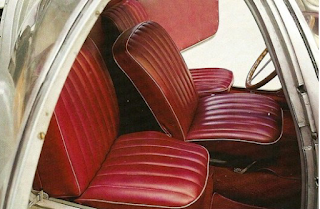Jean Pierre Wimille gained fame if not fortune racing Bugattis before World War II, winning Le Mans twice before turning his attention to work for the French Resistance during the war. He won one of the first automobile races to be run after the war, the Coupe des Prisonniers in the Bois de Boulogne, in 1945, again driving a Bugatti. But by 1946 he revealed a project summarizing his ideas on something he'd been pondering during the long years of the Nazi Occupation: the future of the automobile.
The first Wimille prototype, bodied in Paris by Henri Chapron to Wimille's ideas, didn't much resemble anything that came before it. All of the surfaces were curved in order to conform to a teardrop profile, including a compound curved windshield, curved door glazing, and a roof which followed a teardrop plan while ending in a sloped finlike element sharing the flavor (and poor rearward visibility) of the rear-engined, prewar Tatra T87. The driver sat in the center, however, flanked by two passengers sitting a bit behind his control module. Wimille's goal was to design and build a lightweight V6 power plant, with the power unit mounted forward of the transmission and just behind the 3 seats. Overall, then, the seating layout and engine position were very much like Pininfarina's two Ferrari 365 Tre Posti prototypes from 1966, or Peter Stevens' design for the McLaren F1 road car which appeared in 1992.
Because this was Europe in 1946, Wimille had to contend with shortages of nearly everything, and with costs (including the cost of scarce gasoline) in mind he settled for a 4 cylinder engine from a Citroen 11 (Traction Avant) for his first prototype. Subsequent prototypes featured a French Ford flathead V8 (Wimille had attracted the interest of Ford France in the project), the same tubular chassis and Cotal preselector transmission, and somewhat heaver, less aircraft-influenced styling. This revised body design by Philippe Charbonneaux at least attempted to improve visibility to the rear…
Some sources suggest that as many as 8 prototypes were built, with at least 2 cars surviving today. Photos suggest that no less that 4 frontal styling schemes were tried, including the two different headlight and bumper schemes below…
…and this less appealing Cyclops version. If these lighting schemes and fender forms reflect different cars, then there were no less than 4 different prototypes.
All development on the car came to a tragic and abrupt halt when Wimille died while practicing for the Buenos Aires GP in his Gordini in January 1949. His successors were not able to keep Ford interested in producing the car, and the effort was abandoned. Ironically, just over a year later Lancia released the Aurelia, which featured both the lightweight V6 engine Wimille sought, and a transaxle unit offering savings in space and weight. Unlike most prewar "GP cars for the road" (the Bugatti Type 55, the Alfa 8C 2300 and 2900), the Wimille design approached the program not by adapting existing race car practice, but by attempting to forecast future trends and then to design a practical package around them. Combining a compact, lightweight chassis forecasting the GP winners of 1960 with a humble, easy-to-service power plant, Wimille was aiming at a GP car for Everyman. In retrospect, he came closer than he could have known.
Photo credits:
All photos from carstyling.ru; overhead view of Paris Auto Show from Life Magazine and reprinted in carstyling.ru.







No comments:
Post a Comment